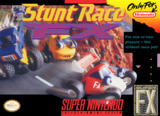3D-Racing Began Here.
Is there anything else to this game other than its great attention to the three-dimensional concept? Yes, there is actually, and I'll outline that below.
As the title screen appears, you can automatically tell that this is no hardcore title, and, like most of Shigeru Miyamoto's creations, almost everything in the game has been personified. Long before that silly "Cars" animation film, this game saw the correlation between a cars headlight and a pair of eyes. Yes, each car has a "face" roughly built from the grill and headlights. To say each car has a personality though might be going too far! So, the graphic shown here is like a cartoon title card, each car (Coupe, F-Type, 4WD, 2WD and a "Trailer") is crammed onto the screen as a pre-cursor of the games light heartedness.
Consistent to other Nintendo releases of the time, racing is arranged in a series of cups, called "classes" in this game. NOVICE, EXPERT (and later MASTER) difficulties are available, and are spread over fifteen courses inclusively. Again, this is a remarkable amount of content for a game of this vintage. On commencement of a race, the three-dimensional track and environment is brought to life in vibrant colour. And, what has become a cliché of today's games, the camera makes a long sweeping zoom down to the grid. Surprisingly, hitting the SELECT button changes the camera view for the game play.
There are three CPU controlled vehicles in this mode, and each car class is represented. I'm not sure how well the classes are balanced over the various racing environments, but finding your own suitable vehicle is an absolute priority. Like many, many games out there, you're often trading acceleration for top-speed, or weight for manoeuvrability. The 4WD is promoted as the starting point for all players, and for most of the game it is a sensible choice.
It's amazing how much has been crammed into each little track. There's wildlife, sunsets, fish, snow and even a cameo appearance of the Arwing squadron, (they fly-over in the "Night Cruise" course). Further to this, there are even individual track musical themes – it's an all-round top-shelf production in terms of visual and sonic quality. You would only find this sort of production value in the cousin of this game: Starwing (or "Star Fox" in other regions).
So, how does it actually play? Well that's where the problem is really. There's usually a mixed view on the playability of this game, with some finding it quite smooth, and others finding it next to impossible to keep of the track barriers. I believe that those looking for a Super Mariokart type experience will not be pleased with this game – there's just too much difference in the style of racing. Control of the cars themselves is difficult to get used to, and if you find the steering over-sensitive, using the shoulder buttons to quick-turn will only compound your problems. Frustratingly, it's not uncommon to hit a wall and be turned right into it, as if the wall has some sort of magnetic properties. Often your car will express the violence of these collisions by shattering apart briefly!
The other difficulty in playing this game is that the frame rate is less than what is required of today's games. Surely, this is a limitation of the Super Nintendo's processing power, and cannot be blamed too harshly, but nevertheless it can be difficult to both judge your speed and the distance between you and the horizon. In a way, it's as if the game is a little too fast for itself, and the slight flickering that occurs is just enough to affect the game play. It's a shame really, and I can't help but think how brilliant things would have been if this could have been tightened up somehow.
But, after all of that, this game has so much to offer that it's hard for me to hold these problems against it. The brightly coloured polygon-built graphics are charming and humorous. The music, constantly varying and lively is a treat as well. Plus, there are four modes for players to pick from. It can be seen that this game, although severely out-dated, has an appeal that time cannot touch. Again, this first party product from Nintendo has had the best efforts applied to it, and it's only the technology of the time that failed to make this game truly sing.

